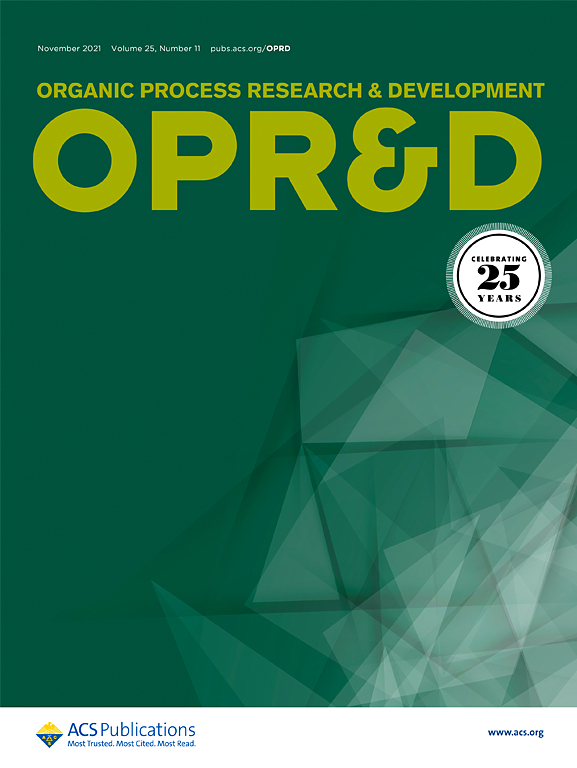Development of a Scalable Anodic Oxidation Process for (R)-Troloxamide Quinone (EPI-589) Using a Continuous Flow Approach
IF 3.1
3区 化学
Q2 CHEMISTRY, APPLIED
引用次数: 0
Abstract
Electrochemical methods in organic synthesis hold significant potential for next-generation chemical processes and are gaining attention not only in the pharmaceutical sector but also across the broader chemical industry. From an electrochemical perspective, electrons can be regarded as a reagent, which can be utilized in various oxidation and reduction reactions. Anodic oxidation is one example, by which it is possible to oxidatively cleave troloxamide to form troloxamide quinone. Thus, an electrochemical process can contribute to the synthesis of the active pharmaceutical ingredient (API) EPI-589, a drug candidate for the treatment of amyotrophic lateral sclerosis (ALS). Process development using electrochemical methods is often regarded as challenging for scale-up and manufacturing, but here we describe the establishment of a manufacturing method by combining the concepts of anodic oxidation (electroorganic chemistry) and continuous processing are described. The results of a scale-up proof-of-concept experiment are shown, in which the API was obtained with excellent quality on a kilogram scale.

连续流动法制备(R)-Troloxamide醌(EPI-589)可扩展阳极氧化工艺
有机合成中的电化学方法在下一代化学过程中具有巨大的潜力,并且不仅在制药部门而且在更广泛的化学工业中受到关注。从电化学的角度来看,电子可以看作是一种试剂,可以用于各种氧化和还原反应。阳极氧化是一个例子,通过它可以氧化裂解troloxamide以形成troloxamide醌。因此,电化学过程可以促进活性药物成分(API) EPI-589的合成,EPI-589是治疗肌萎缩性侧索硬化症(ALS)的候选药物。使用电化学方法的工艺开发通常被认为是扩大规模和制造的挑战,但在这里,我们描述了通过结合阳极氧化(电有机化学)和连续处理的概念来建立一种制造方法。结果显示了一个按比例放大的概念验证实验,其中API在公斤规模上获得了优异的质量。
本文章由计算机程序翻译,如有差异,请以英文原文为准。
求助全文
约1分钟内获得全文
求助全文
来源期刊
CiteScore
6.90
自引率
14.70%
发文量
251
审稿时长
2 months
期刊介绍:
The journal Organic Process Research & Development serves as a communication tool between industrial chemists and chemists working in universities and research institutes. As such, it reports original work from the broad field of industrial process chemistry but also presents academic results that are relevant, or potentially relevant, to industrial applications. Process chemistry is the science that enables the safe, environmentally benign and ultimately economical manufacturing of organic compounds that are required in larger amounts to help address the needs of society. Consequently, the Journal encompasses every aspect of organic chemistry, including all aspects of catalysis, synthetic methodology development and synthetic strategy exploration, but also includes aspects from analytical and solid-state chemistry and chemical engineering, such as work-up tools,process safety, or flow-chemistry. The goal of development and optimization of chemical reactions and processes is their transfer to a larger scale; original work describing such studies and the actual implementation on scale is highly relevant to the journal. However, studies on new developments from either industry, research institutes or academia that have not yet been demonstrated on scale, but where an industrial utility can be expected and where the study has addressed important prerequisites for a scale-up and has given confidence into the reliability and practicality of the chemistry, also serve the mission of OPR&D as a communication tool between the different contributors to the field.

 求助内容:
求助内容: 应助结果提醒方式:
应助结果提醒方式:


